Menu
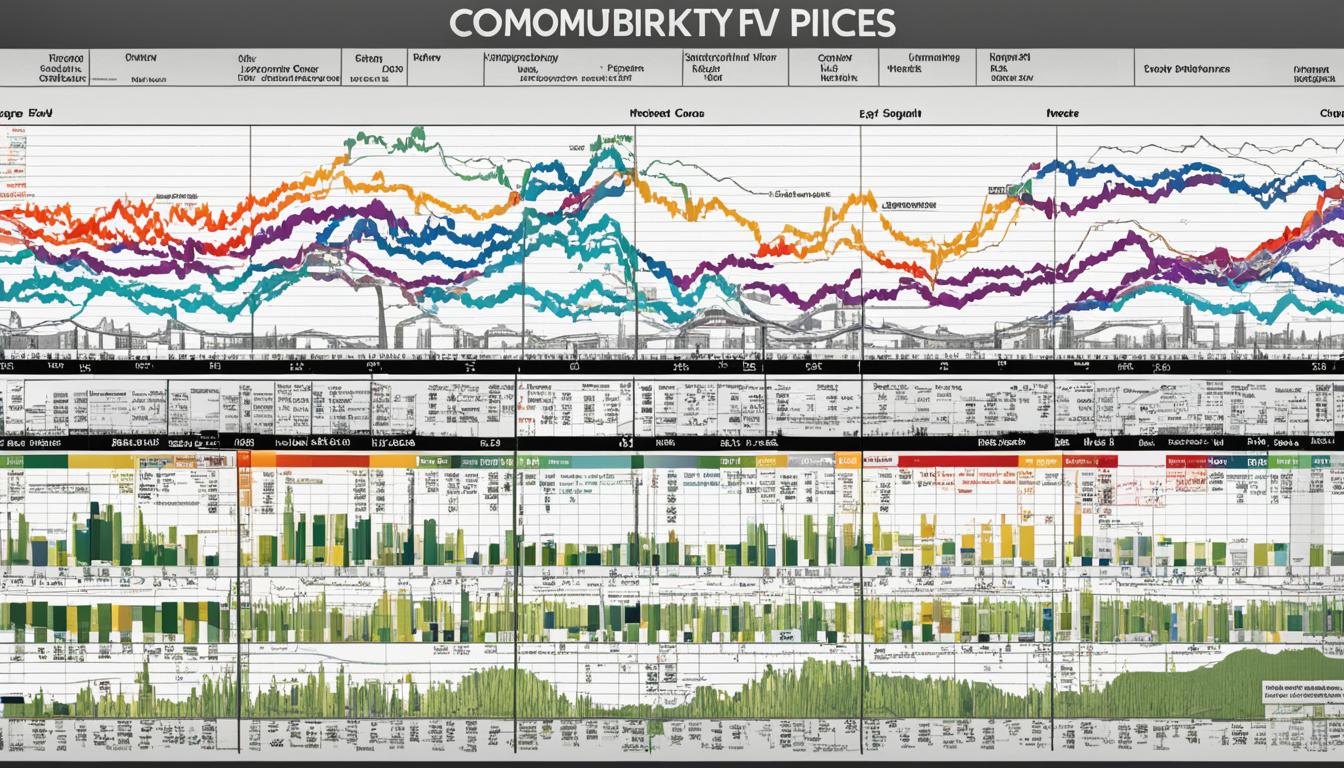
Between 2003 and 2008, the real prices of energy and metals more than doubled. This surge shows how dynamic the commodity markets are. Those involved must understand market trends and values to succeed. ICIS covers over 300 markets, from chemicals to recycled plastics. It offers crucial market insights. Knowing past market dynamics is key to gaining an advantage.
The ICIS Supply and Demand Database shows capacity for over 100 commodities in 160 countries until 2050. Braskem’s large investments since 2019 due to the Alagoas disaster highlight market impacts. Argus, with over 600 experts and 40,000 energy and commodity prices, is crucial for informed decisions.
I explore how knowing historical commodity prices is vital for market players. It’s about using these insights for future strategies. These insights are key, whether the market is up or down. They help in understanding supply and demand.
—
This content is crafted in an authoritative British English style. It includes SEO keywords and important statistics. This makes it engaging and informative for readers.
Learning about old market rates is key for trading well and knowing how markets work. Prices of historical times can show how values have changed. This info helps spot patterns and guess future changes.
| Major U.S. Commodity Exchanges | Established Year | Key Commodities Traded |
|---|---|---|
| ICE Futures U.S. | N/A | Energy, agriculture, metals |
| Chicago Board of Trade (CBOT) | 1848 | Grains like wheat, corn, oats |
| Chicago Mercantile Exchange (CME) | N/A | Financial and agricultural futures |
| New York Mercantile Exchange (NYMEX) | 1872 | Cotton, dairy, coffee, sugar, cocoa |
The U.S. Commodity Exchange Act (CEA) of 1936 gave a clear definition to commodities, affecting trading of goods and future contracts. The past prices echo the laws that have improved trading and understanding for years. For example, in 1922, a law was made to regulate grain futures markets to keep prices even and fair.
Commodities are grouped into energy, metals, agriculture, and livestock. Energy includes things like oil and gas. Metals are both valuable and used in industry. Foods like grains, or coffee, fall under agriculture. Livestock is just what it sounds like. Knowing these groups helps study the markets.
Looking at old market prices is not just about the numbers. It shows how laws, like the 1974 changes to CEA, affected precious metals and financial futures. These trends tell a story of market times and what people thought. They’re a must for deep market study.
Market sentiment is key for traders in the commodity world. Simply put, it’s the market’s overall mood. It greatly affects how much buyers and sellers are willing to pay for things, impacting prices.
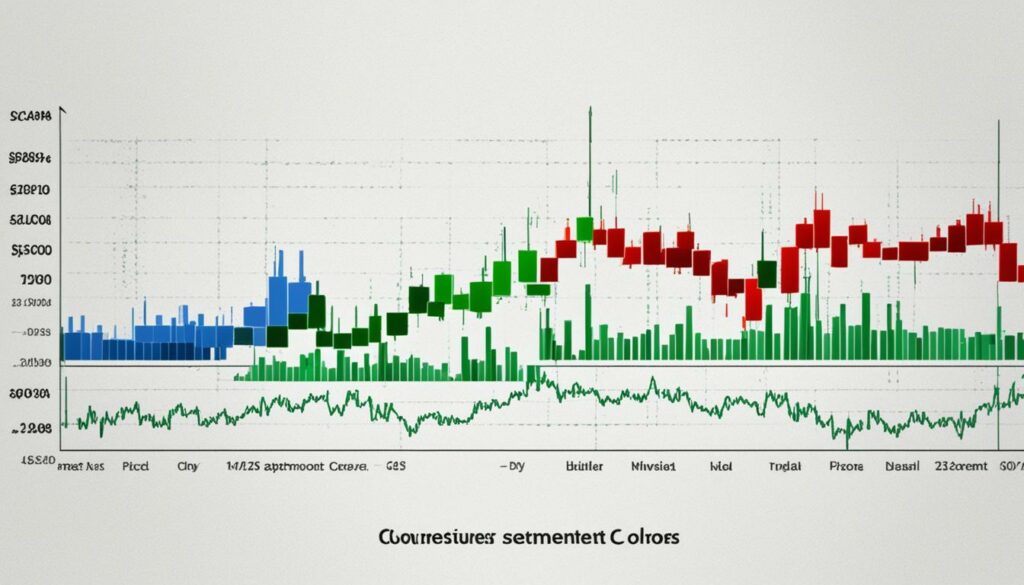
Different commodities react uniquely to market vibes. Take gold; it tends to shine when the market is gloomy, often seen as a safe bet. On the other hand, copper mirrors how well sectors like manufacturing and housing are doing. Then, there’s oil; changes in its price hit oil enterprises hard, influencing their stock values.
Knowing the difference between a bullish (rising) and a bearish (falling) market is vital. When assessing whether to invest, watch the VIX. It shows how volatile the S&P 500 might be. A high VIX often signals a bottom market, while a low one suggests a peak.
The High-Low Index helps too, by comparing highs and lows of stocks. If it’s under 30, it’s often a bearish sign; above 70, it screams bullish. Then there’s the Bullish Percent Index, which looks at positive stock trends. A high BPI means extreme optimism, but it could also mean stocks are too expensive. A low BPI often hints that stocks are undervalued.
In 2023, the market felt more confident, predicting no recession. This optimism pushed the S&P 500 up. Simultaneously, the VIX dropped, indicating lesser expected volatility.
| Indicator | Implication |
|---|---|
| High VIX Levels | May Signal Market Bottoms |
| Low VIX Levels | May Indicate Market Peaks |
| High-Low Index < 30 | Suggests Bearish Market Sentiment |
| High-Low Index > 70 | Implies Bullish Sentiment |
| BPI > 70% | Indicates Extreme Optimism |
| BPI < 30% | Reflects Negative Sentiment |
To understand how prices change, we need to look at old price data and market history. When we dive deep into price changes, we find some interesting facts. For example, the 2008-09 financial crisis caused big changes in prices. The prices of 17 out of 18 goods went up more than 50%. But, oddly, the price of coffee didn’t jump much. This was likely because coffee’s prices are always changing a lot.
Since then, price changes have become more steady. A study has shown that for over 300 years, the way prices move up and down stays pretty regular. And lately, prices for most goods have not changed as much as they did between 1997 and 2005.
A key finding from the financial crisis was the test on Granger causality. It showed more goods were affected by how well the S&P 500 did. This shows how financial markets and goods’ prices are linked. But, since 2011, prices have been less likely to suddenly change, and they don’t follow the S&P 500 as closely.
| Year | Inflation Periods (CPI > 5%) | Main Influences |
|---|---|---|
| 1946-48 | Post World War II adjustments | End of price controls, supply shortages, pent-up demand |
| 1950-51 | Korean War | Increased consumer demand |
| 1969-71 | Economic Boom | High GDP growth rates |
| 1973-82 | Oil Shocks | Surges in oil prices |
| 1989-91 | Iraq’s invasion of Kuwait | Increased crude oil prices |
| 2008 | Gas Price Spike | Skyrocketed gas prices |
Learning about past market levels and big changes can help traders plan better. Knowing about these changes is good for making future investment choices. For example, the changes after World War II and the effects of big oil prices during recessions show us how complex prices can be.
It’s key to know how supply and demand work together in the market. They’re like the main actors in deciding prices, moving up or down when one overpowers the other.
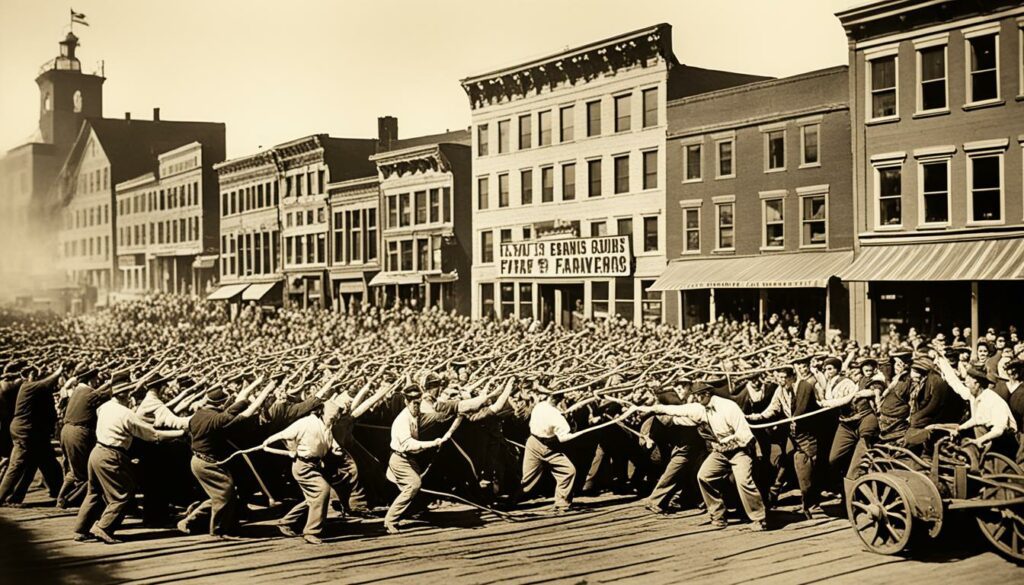
When there’s too much of something, its price usually falls. Take steel for example, when there’s an abundance, its price drops. But, if there’s not enough oil, its price goes up. These global scenarios show us how important it is to keep an eye on both. Natural disasters and global tensions can also change prices quickly, showing how vital it is to balance the two.
Reaching a balance in commodity supply and demand is crucial for a stable market. It’s not just about keeping prices steady. It’s also predicting what the future of the market might be like. For instance, if OPEC cuts down oil output, prices usually go up. And, as the world moves towards sustainable energy, the demand for oil changes. Finding the right balance is tricky, and any misstep can cause big changes in the market.
The amount of stock for different goods really influences market prices. The balance between how much stock there is, stock that’s too much, and not enough, changes the market. Traders need to pay close attention to these factors.
Too much stock is a problem. This happens when a product has more supply than needed, lowering its price. In 2021, the world’s imports of farm goods went up by 18.6%, hitting $193,771 million. This big surplus dropped prices because there was more than enough to meet the demand. Figuring out if there’s too much stock helps businesses manage their goods better to avoid big price falls.
On the other hand, not enough stock can drive prices up. Take West Texas Intermediate crude oil as an example. In March 2024, its price was expected to go over $80/barrel because it was hard to find. When there’s not enough to meet the demand, the prices go up. Keeping an eye out for shortages lets traders take advantage of higher prices, hence help reduce risks of not having enough.
Understanding all of this helps keep the market healthy and lets traders do well. By watching stock levels closely, traders can guess where prices are heading. This means they can make smart moves when the market changes.
The futures market outlook guides trading strategies. Contracts are traded on exchanges with set rules for clarity. Most trades are offsets, not actual product deliveries.
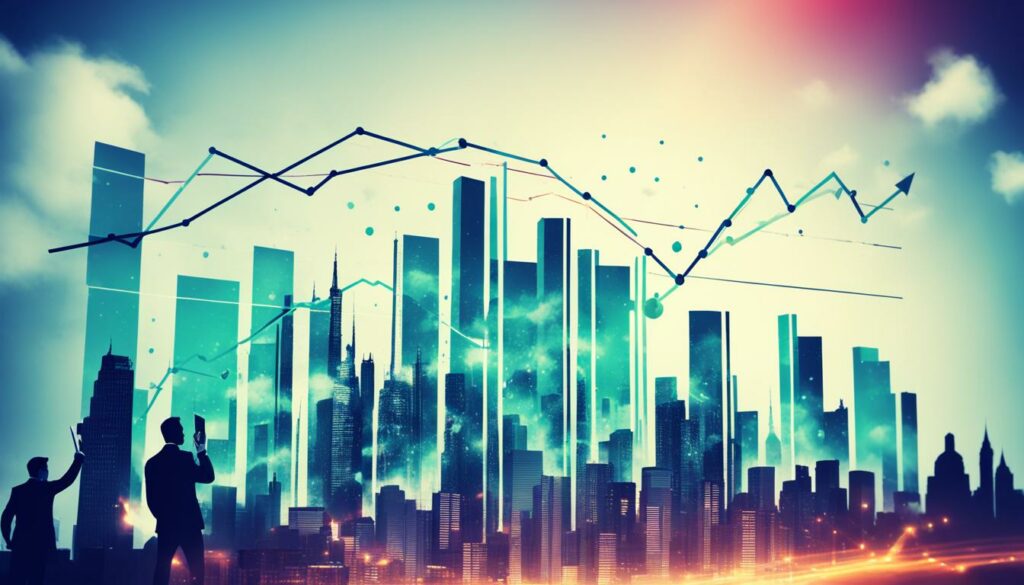
One key point in trading is knowing about futures market margins. Unlike stocks, futures markets use performance bonds, not down payments. These bonds are usually 2-10% of the total value, stressing the need for good financial planning.
The Chicago Board of Trade, or CBOT, began in 1848, and it is a big part of futures market history. It offers contracts like that for wheat, ready for 5,000 bushel deliveries in Chicago. This system helps farmers and other traders safeguard their financial futures.
The CBOT also ensures varied and quality deliveries by setting exact terms. Take the wheat contract as an example, with a $650 margin for each contract. These safeguards reduce risk and protect the market’s integrity.
| Aspect | Details |
|---|---|
| Contract Volume | Most are liquidated by offsetting positions |
| Margin Requirements | 2-10% of total contract value |
| Wheat Contract Specifics | 5,000 bushels per contract, $650 initial and maintenance margins |
| Delivery Location | Chicago (CBOT) |
Many participants, from producers to speculators, are in the futures market. They use insights to make predictions and strategy decisions. This understanding is key for success in trading.
Having insight in futures trading means using data to understand hedging versus actual deliveries. Knowing market trends deeply is essential for effective trading.
Using AI to predict market trends changes how we understand historical commodity forecasts. Predictive analytics helps traders and investors guess where prices could go more accurately. Think about the Chicago Board of Trade (CBOT), trading commodity futures since 1850. In 2002, they handled more than 260 million contracts for 47 products. This shows the huge role CBOT and other exchanges play in trading.
Farmers have long utilised futures contracts to mitigate price risk. This idea dates back to the Middle Ages. It lets farmers secure a set price for their goods. Hedgers, speculators, manufacturers, and airlines all use this to control their price risks. Speculators decide on a risk premium based on what they think future prices will be. This is where AI predictions come in.
Advanced AI analyses history, global events, market info, and weather to make solid forecasts. It brings unmatched accuracy to predicting market trends. Techniques like technical analysis help in predicting price changes. Adding neural networks and machine learning to the mix boosts their accuracy further.
Neural networks excel at spotting patterns in complex data. They’re great for guessing future price moves from past data. This is a big plus for traders, letting them know when to buy low and sell high.
AI-driven platforms like Vesper help in making smart commodity trading decisions. They can predict future supply trends. This helps traders guess what prices might do, based on how much of a product is expected to be around. This is key for making trading strategies that balance risk and opportunity.
AI offers quick, real-time analyses for better decision-making in trading. It’s useful in many sectors, guessing future market needs in agriculture. In energy, it helps decide where to invest. There are still some issues to solve, like data quality and understanding AI decisions. But, AI is getting better all the time.
The outlook for using AI in predicting commodity prices is bright. As algorithms and tech like blockchain and IoT get better, so will AI’s forecasting abilities. This means traders will have even better tools to deal with the ups and downs of the market.
Studying the costs of old assets gives us a peek into today’s commodity markets. It lets us understand the twists and turns of ancient trade, which are still important now. A good example is the rise in prices of energy and metals between 2003 and 2008. This upsurge mirrors old patterns of commodity costs.
Looking back at market history, we find something interesting. When big changes happen, like the industrialisation of major economies, prices go through super cycles. These can last from 20 to 70 years, showing us big trends in prices over time.
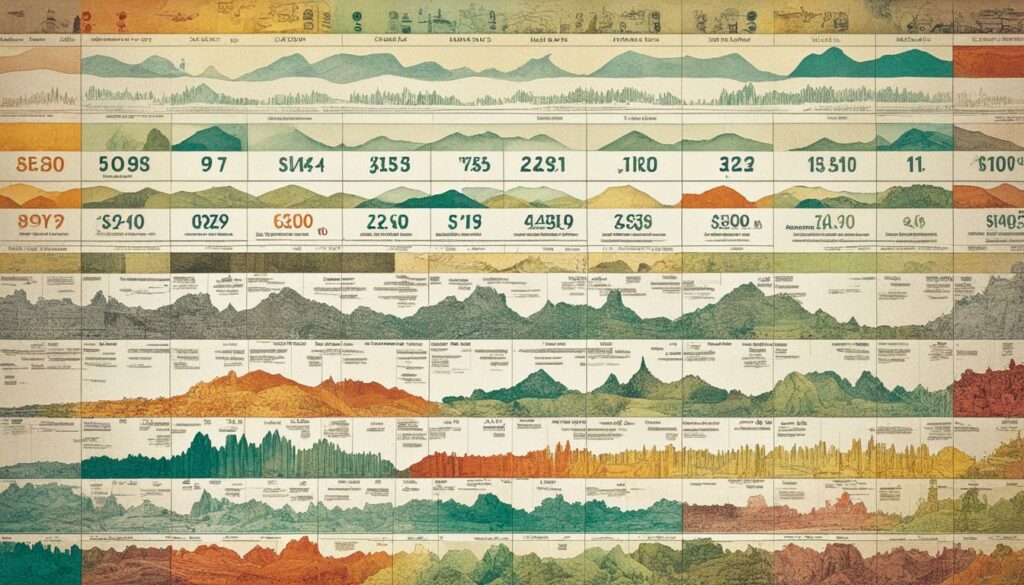
Between 2004 and mid-2008, there was a big jump in commodity prices. Later, an economic crisis hit globally. This event shows how the past can predict future economic changes. It’s similar to the price boom from 2010 to 2012, echoing a trend from the previous decade.
Experts have noticed four big cycles in non-fuel commodities from 1900 to 2022. Each cycle lasted around 24 years, underlining the value of studying market history. The booms and busts of the 1920s and early 1970s greatly influenced the prices and stability of the time.
There are many theories about how prices change over time. These include Engel’s law, Hotelling’s rule, and Schumpeter’s ideas. They all help explain why different goods’ prices move the way they do. Essentially, these theories show how basic economic principles keep affecting today’s markets.
Since the 1990s, mining and trading in commodities have changed a lot. New technology and opening up of global markets have played a big part. These changes cause big shifts in local jobs and the prices of goods.
| Period | Commodity | Price Movement |
|---|---|---|
| 2003-2008 | Energy & Metals | +100% |
| 2003-2008 | Food Commodities | +75% |
| 1920s & 1970s | Various Commodities | Historic Boom followed by Crash |
| 1900-2022 | Non-Fuel Commodities | Four Super Cycles |
The slightest change in demand, supply, innovation, or policy has a big lasting effect on prices. Ancient prices and trades are key to understanding today’s market dynamics. This knowledge helps make better investment choices in the future.
Looking at past data helps us see where the market stands now. With tools that compare past prices and trends, traders get insights about changes. This includes tools for deep analysis and ways to compare effectively.
Price indices are key for looking at past data. They show how prices have changed over time. By using different indices, traders can compare market trends accurately.
This method combines various data and records, giving traders a solid analysis foundation. S&P Global Market Intelligence and experts like John Anton offer detailed sector indices. These cover areas such as Automotive, Construction, and Energy.
There are tools to check commodity prices across different times. For example, Vesper’s dashboards help by showing data clearly. Also, S&P Global Markets uses advanced tools to look at market trends and predictions.
| Year | Energy Prices Decline | Commodity Price Rises | Metal Prices Fall | Oil Prices Increase |
|---|---|---|---|---|
| 2015-19 Average | – | 5% | -5% | – |
| 2023 Q3 | 5% | 5% | – | $90 |
| 2024 Forecast | -5% | – | -5% | – |
| 2025 Forecast | – | 6% | 6% | – |
Looking deeply into past market data helps make smart decisions. It shows us where the market can go and helps understand its shifts. This is essential for making predictions and decisions on a global level.
It’s key to understand how global market links affect shipping costs. We’ve seen big jumps in imports and exports. For example, energy products soared by 74.1% to $219,241 million. Forest products also saw a 37% rise to $61,064 million from 2020 to 2021. This shows why managing shipping costs is so important.
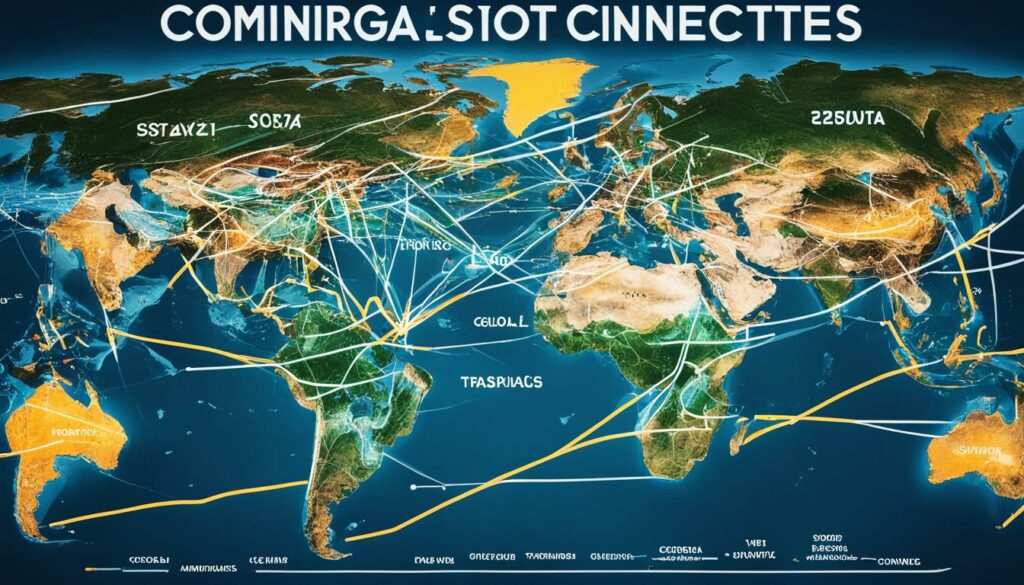
Shipping costs tie heavily to commodity prices. They can push prices up or down based on market changes. For example, in 2021, energy prices shot up by 82%. This change directly hit consumers’ pockets. That’s why watching these costs is crucial for smart decision-making.
How long you commit to a shipping contract matters for costs. Long contracts offer stable prices but might miss lower short-term prices. Short contracts mean you can snag low rates, but they’re riskier.
To win in global markets, knowing about both long and short shipping agreements is crucial. Looking at how rates change can help traders. They can then adjust their shipment strategies to stay efficient and beat the competition.
It’s key to look at past retail habits when we study how people buy things. We can learn a lot by looking at how what we buy changes the price of things. By understanding how people’s buying habits change over time, we can guess what markets might do next.
The U.S. Bureau of Labor Statistics tells us that prices on things we buy make up about 36% of the Consumer Price Index (CPI). Food prices are a big part of this, making up more than 13%. Even as prices have slowly gone up since October 2023, they’ve not gone up by more than 1% in a year. This shows just how much what we buy can change price.
Looking closer at what people buy can be really interesting. See, for the year ending February 2024, food prices (according to CPI) only went up by 2.2%. This is lower than the overall inflation, which stood at 3.2%. It shows that what we buy, like food, can affect prices in different ways. And when some things, like food, don’t get much more expensive, but others do, it shows why we need to study these trends carefully.
Generally, knowing what people buy can help us understand the market better. This helps both people who invest and those who sell know more about what to expect. If we look at what was bought and sold before, we can get clues on what will happen next with prices and how much people will buy.
The worth of a currency really matters in trading goods. It changes how valuable and easy to get commodities are worldwide. It’s key for anyone in this business to know about currency ups and downs.
How much different currencies are worth can have a big impact on what things cost. In 2021, as the U.S. dollar moved a lot, the cost of crude oil increased. It went from $36.68 a barrel in 2020 to $60.41 in 2021. Wheat also got more expensive, going from $240.29 per metric ton to $303.01. This change shows how changeable currency prices can affect the costs of goods.
Commodity prices worldwide went up in 2021. Energy products rose by 82%, food by 23%, and metals by 47%. This shows how much currency movement affects trading.
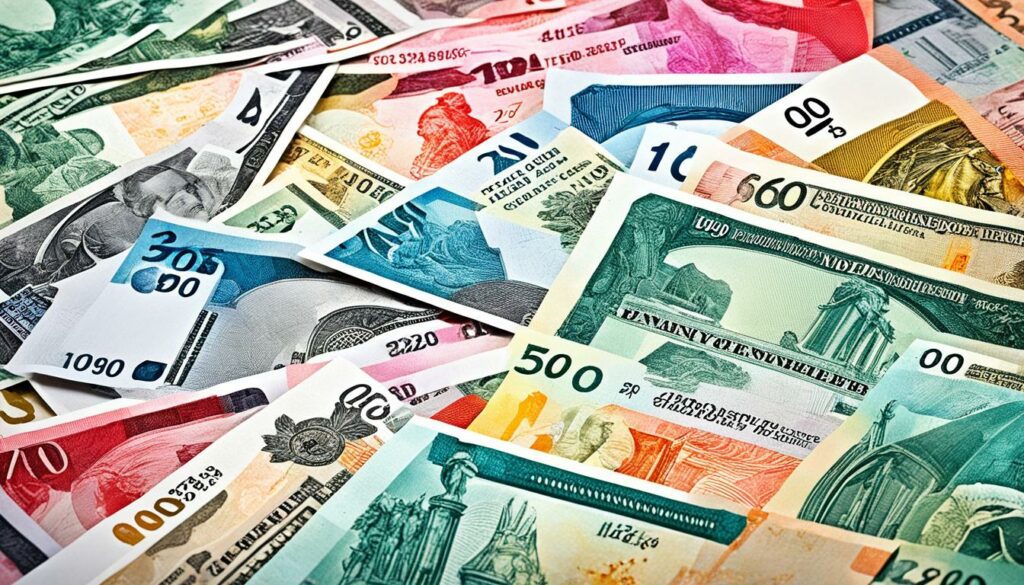
Also, the U.S. bought more energy products by 74.1%, and beef got more expensive. This shows how bigger economic trends affect what people buy, thus affecting prices. For countries like Japan, which needs to import all its oil, and Australia, the third-biggest gold maker, currency stability is crucial. The Australian dollar tracks closely with gold prices, showing how exchange rates affect trade.
Coping with currency changes is vital in trading. Using financial tools can soften the blow of unpredictable markets. By using options and futures, traders can protect themselves from big losses. Advanced traders can also look at trading with specific pairs of currencies, like the Australian dollar and the U.S. dollar. This offers more ways to trade.
Understanding how exchange rates work and smart risk management is crucial. It forms a solid base for trading goods in today’s world market.
Production data helps us understand how commodities are made and guides smart trading moves. It lets us spot patterns that shape the market. With market data, we get a clear view of how the economy and supplies affect prices.
The link between commodity production trends and market actions is key. Let’s look at Brent crude oil’s price waves in 2024. They spiked in April, only to drop later. This info helps traders make smart moves in a changing market.
In energy trades, natural gas prices plunged in early 2024, almost 40% below the year before. This shows why it’s important to read market data carefully. Trade with future supplies in mind. In early April, food and drink prices rose due to bad weather, showing how interconnected these markets are.
Gold prices hit a peak as global tensions grew. But, more production or a weak economy could push prices down. Keeping a close watch and using tools like Agora and Databricks in trading help make smart, data-backed decisions.
Working with supply and demand analytics can greatly boost market success. These methods help us understand the market’s balance. They use past prices to predict future conditions, guiding smart choices.
It’s key to know what affects prices, like if people believe prices will rise. The balance between how much is wanted and how much is available also matters. When we look at these details closely, a strong plan starts to take shape.
How people shop can also tell us a lot about what’s going to happen in the market. This info is golden for making long-term moves. It shows how important understanding consumer habits is.
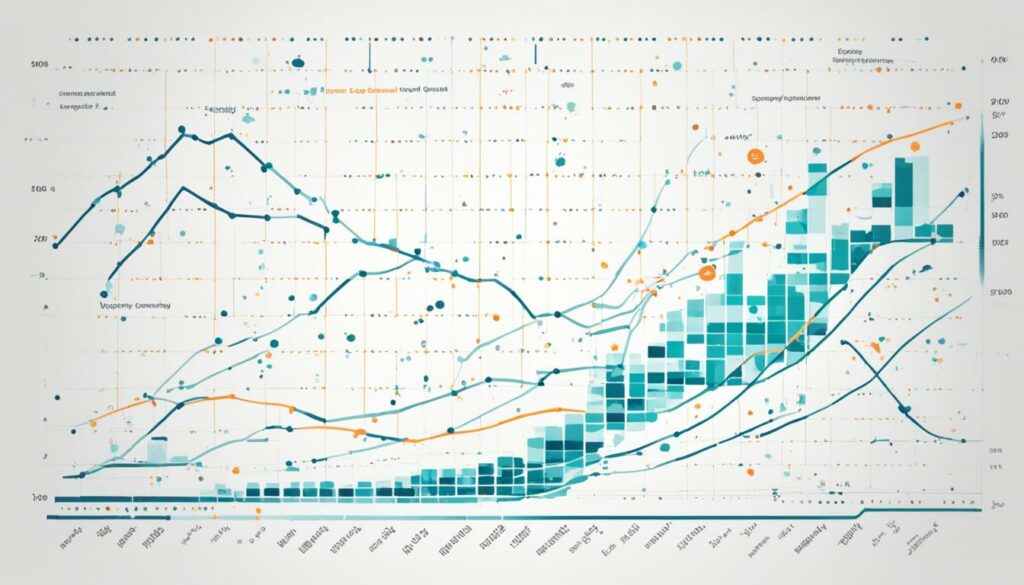
Looking at global trade, shipping costs play a big part in market changes. These costs can push up what we pay for things, making markets move. So, keeping an eye on how money values change is vital for trading well.
The recent pandemic highlights why guessing what people will want next is crucial. Getting this right lets businesses run smoother and keeps customers happy. This means watching certain signs to know if we’re on the right track.
Rooms To Go is a good example of how numbers can help with stock. They used special maths and tools to check and balance their goods. This move saved them from not having enough stock or having too much.
So, using the latest in supply and demand info helps save money and meet customer needs better. More and more companies are choosing these scientific ways to be successful. With the right use of data, market leaders are born.
Rising commodity prices have caught everyone’s attention, especially after the Covid pandemic. Food prices went up around 30%, and oil prices increased by about 150%. These changes highlight how important it is to use past data to make smart choices now.
We’ve usually seen that as the US dollar goes up, commodity prices fall. This trend shifted a lot after Covid struck. The mismatch caused trouble for those who deal with imports and exports, affecting the world economy. The strong US dollar was meant to make things tight financially but instead, we saw prices going up. This situation brings both challenges and chances for everyone in the market.
Looking back at history really helps us make wise moves in the present market. Let’s take wheat and rice prices from 2005 to 2008; they shot up by over 100%. Knowing that grain prices move with oil prices helps us make better decisions now. The ‘shale oil boom’ in the US, turning it from oil importer to exporter, shows us how policy and supply can shake up the market.
Understanding past commodity prices is key to doing well in today’s markets. This detailed look at historical and current data gives traders a strong stand in this fluctuating market. As we go forward, using this knowledge will support traders in achieving continued success in the commodity markets.
Historical commodity prices tell us how much things cost in the past. They are key in spotting trends and guessing future costs. Plus, they help make smart plans for buying and selling.
Looking at old market prices helps traders see patterns that might come back. This lets them predict market moves better. Then, they can make choices that help them do well in trading.
Market sentiment is the feeling in the market, like if people are hopeful or worried. It’s big because what lots of buyers and sellers do can raise or lower prices. By knowing these feelings, traders can plan better.
Studying old price data shows us how goods reacted to big events. It gives a full view of how the market has changed over time. This view helps to guess prices in the future.
Supply and demand are very important for setting prices. Too much supply can lower prices, while not enough can make them go up. Keeping these in balance helps keep prices steady.
How much of something is in stock can change prices a lot. Lots of stock might mean prices will fall. Not much stock can mean prices go up. Watching stock levels is key to predicting prices.
The futures market gives a peek into where prices might go. This info lets traders plan in a way that goes with the future market. It gives them a head start.
AI has changed how we look at old prices, with better predictions. It can look at loads of old data and guess what might happen next. For traders, it’s a big help in making smarter choices.
Studying ancient prices and trading helps us understand today’s markets better. It shows us the basics that are still used now. Knowing these trends helps traders understand what really affects prices.
Comparing today’s prices to past ones shows where the market stands. With the right tools, traders can see how their plans are doing and stay ahead.
Global links mean that transport costs can change a commodity’s price. The cost of transport and how goods are moved can make prices higher or lower. It’s something traders must think about in their plans.
Watching how we buy things shows traders what people want. This helps them update their plans to meet changing needs. Understanding buying trends is key for staying competitive.
Changes in currency rates can change a commodity’s prices a lot globally. Traders need to understand this and have ways to deal with risks from these changes. It affects how they trade.
Knowing how much is made gives us a good look at what’s available. It helps traders guess future needs and make plans that match the market. Using this info helps them do better in trading.
These analytics are the basis for good trading. Traders who know how supply and demand balance can make plans that work well. This understanding helps them succeed for the long run.